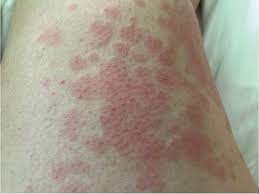L
 Inflammatory process with high fever that recurs daily, polyarthritis, rash, leukocytosis, and may be associated with lymphadenopathy, hepatosplenomegaly, and mild increase in liver function tests.
Inflammatory process with high fever that recurs daily, polyarthritis, rash, leukocytosis, and may be associated with lymphadenopathy, hepatosplenomegaly, and mild increase in liver function tests.
A rare disease process, with an estimated prevalence of fewer than 35 cases for 1 million persons, and occurs more commonly in women than in men.
Pathogenesis is incompletely understood, but a combination of genetic predisposition and exposure to infectious, malignant, or environmental triggers is considered to precipitate dysregulated, pro inflammatory immune response.
The nucleotide binding oligomerization domain – like receptor protein 3 (NLRP3) inflammasome activation leads the production of IL-1beta, and IL-18,and the subsequent release of IL-6, IL-8 and tumor necrosis factor with possible impaired or down regulate anti-inflammatory mechanisms that affect regulatory T cell function or IL – 10 production.
Adult Still disease is associated with specific HLA types and polymorphisms in macrophage migratory inhibitory factor and IL – 18.
Extremely high IL-18 levels typically greater than 25 ng per liter strongly, suggests Stills disease.
Fever typically quotidian and spiking, often in the evening.
Adult onset Still’s disease.
A form of Still’s disease, a rare systemic autoinflammatory disease characterized by the classic triad of persistent high spiking fevers, joint pain, and a distinctive salmon-colored bumpy rash.
Onset is associated with physical and emotional stress in year preceding manifestation of disease.
Typically is diagnosed in patients older than 16 years of age.
Etiology suggested to be due to immune dysregulation.
A diagnosis of exclusion.
A clinical diagnosis.
Incidence approximately 0.16 cases per 100,000 person-years.
Incidence slightly higher in women.
Mean age at presentation is 38 years.
Two thirds of patients older than 35 years of age (Kadar J).
Etiology unknown, but viral and bacterial pathogens suspected.
Arthritis prevalence estimated at 64-100% and can progress to joint deformities in patients with refractory or in adequately treated inflammatory joint disease.
Typically associated with normochromic anemia and thrombocytosis.
Pulmonary infiltrates and renal involvement may occur.
Rash is non pruritic, non tender, macular/papular, salmoned color on trunk and extremities.
The rash primarily affects the proximal limbs and trunk, sparing the limbs and face.
The rash can be misdiagnosed as a drug eruption, due to occasional mild pruritis and the tendency to occur during fever attacks.
Biopsy of rash reveals edema and perivascular inflammation.
Arthritis/arhrlagias involve knees, wrists, elbows, proximal interphalangeal joints and shoulders.
Synovial fluid analysis reveal inflammatory changes with a mean WBC count of 13,000mm3.
Mild increases of CPK and aldolase may occur, with myalgias, but muscle biopsy is normal.
Acute phase reactants ESR, CRP and ferritin may be elevated.
Patients may present with pleuritis, pericarditis, pleural effusions, myocarditis, and transient pulmonary infiltrates.
There is often involvement of the eye, migratory myalgias, abdominal pain, and rash.
65% of patients have lymphadenopathy.
One third of patients have a sore throat and may be the initial presenting symptom.
Biopsy of lymph nodes reveal benign changes of polyclonal B cell hyperplasia.
70% of patients have mild elevations of liver function tests at some point during their illness.
Symptoms last weeks to months before the diagnosis is made.
Yamaguchi Diagnostic criteria (Yamaguchi A):
Major
Arthritis or arthralgia 2 weeks or longer with swelling and limited movement
Fever 39C or greater, persistent or intermittent for 1 week or longer.
Typical evanescnt, salmon colored, macular/papular on trunk or extremities, associated with fever.
Leukocytosis 10,000mm3 or higher and 80% neutrophils.
Minor
Sore throat
Lymphadenopathy and or splenomegaly
Elevated liver functions
Negative rheumatoid factor and ANA tests
Exclusion
Infections, malignancies and rheumatic diseases.
Diagnosis requires 5 criteria and at least 2 of them must be major in nature.
Yamaguchi criteria has a relatively high sensitivity and specificity , at 96.5% and 92.1% respectively.
Patients with adult Still’s disease have elevated levels of inflammatory markers, including:ferritin, CRP, ESR, and elevation in IL – 2 receptor, IL-6, IL – 18, TNF – alpha, CXCL9, CXCL10, CXCL 11 and CXCL 13.
Fever usually daily or twice daily and usually in the evening.
Wide fever fluctuations occur and in 20% of patients temperature does not resolve between spikes.
Three distinct patterns of disease: self-limited or monocyclic, intermittent or polycyclic and chronic articular.
Monocyclic disease has a systemic presentation that resolves completely within one year.
Self-limiting course in one third of patients and can take up to one year to resolve.
One third of patients have persistence of active disease with destructive arthritis.
Complications include destructive arthritis, fulminant hepatitis, coagulopathy such as DIC or thrombotic thrombocytopenic purpura.
12 to 14% of patients with adult onset Still’s disease develop a macrophage activation syndrome, which is a hyperinflammatory state that can lead to cytokine storm and multiorgan dysfunction.
Pulmonary involvement includes diffuse hemorrhage, pulmonary arterial hypertension, interstitial lung disease, and alveolar proteinosis.
Polcyclic is a relapsing form, with complete remission in between episodes.
Chronic articular adult onset Still’s disease is often severe with poor prognosis leading to joint distruction.
Macrophage activation syndrome, is a recognized complication of disease with an excess of activation of the reticuloendothelial system leading to macrophage activation and the destruction of hematopoetic cells.
Macrophage activation syndrome occurs in 10-17% of cases, with a mortality rate of 10-22%.
Bone marrow examination showing macrophage hemophagocytosis is diagnostic.
Macrophage activation is often triggered by infections, medications, or disease flares, and its manifestations include fever, hepatosplenomegaly, lymphadenopathy, coagulopathy, cytopenias, elevated ferritin levels and can progress to shock and death.
Non steroid anti-inflammatory drugs and corticosteroids are the primary treatments to manage fever, inflammation, arthritis.
Second line treatments include tumor necrosis factor inhibitors, infliximab and etanercept.
Methotrexate may be used if steroids are contraindicated.
Treatment for macrophage activation syndrome involves immunomodulatory agents, including high dose glucocorticoids, IL –1 inhibition drugs, intravenous immune globulin therapy, methotrexate, calcineurin inhibitions and JAK1 inhibitors.
patients with mild adult onset Still’s disease may be treated with nonsteroidal anti-inflammatory agents, however, for moderate to severe disease treatments now include biologic agents that inhibit pro-inflammatory cytokines, including IL –1 and IL – 6.
IL –1 inhibitor anakinra is often the preferred initial monotherapy.
Canakinumab a IL-1 beta inhibitor has a longer half-life of approximately 23 days, and allows for monthly administration.
The use of IL-6 inhibitor tocilizumab also efficacious.
